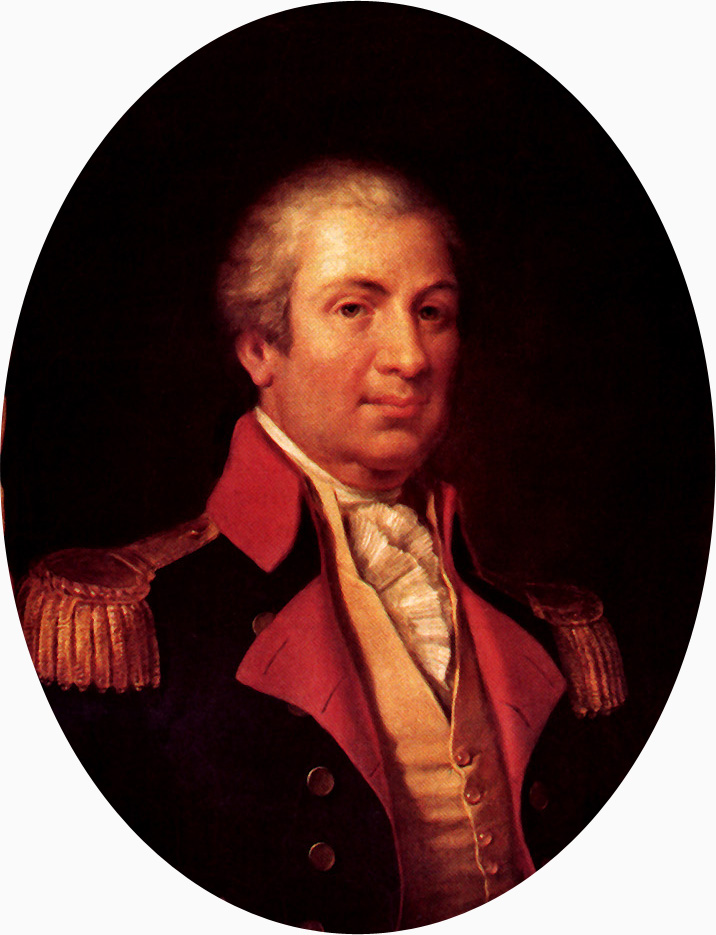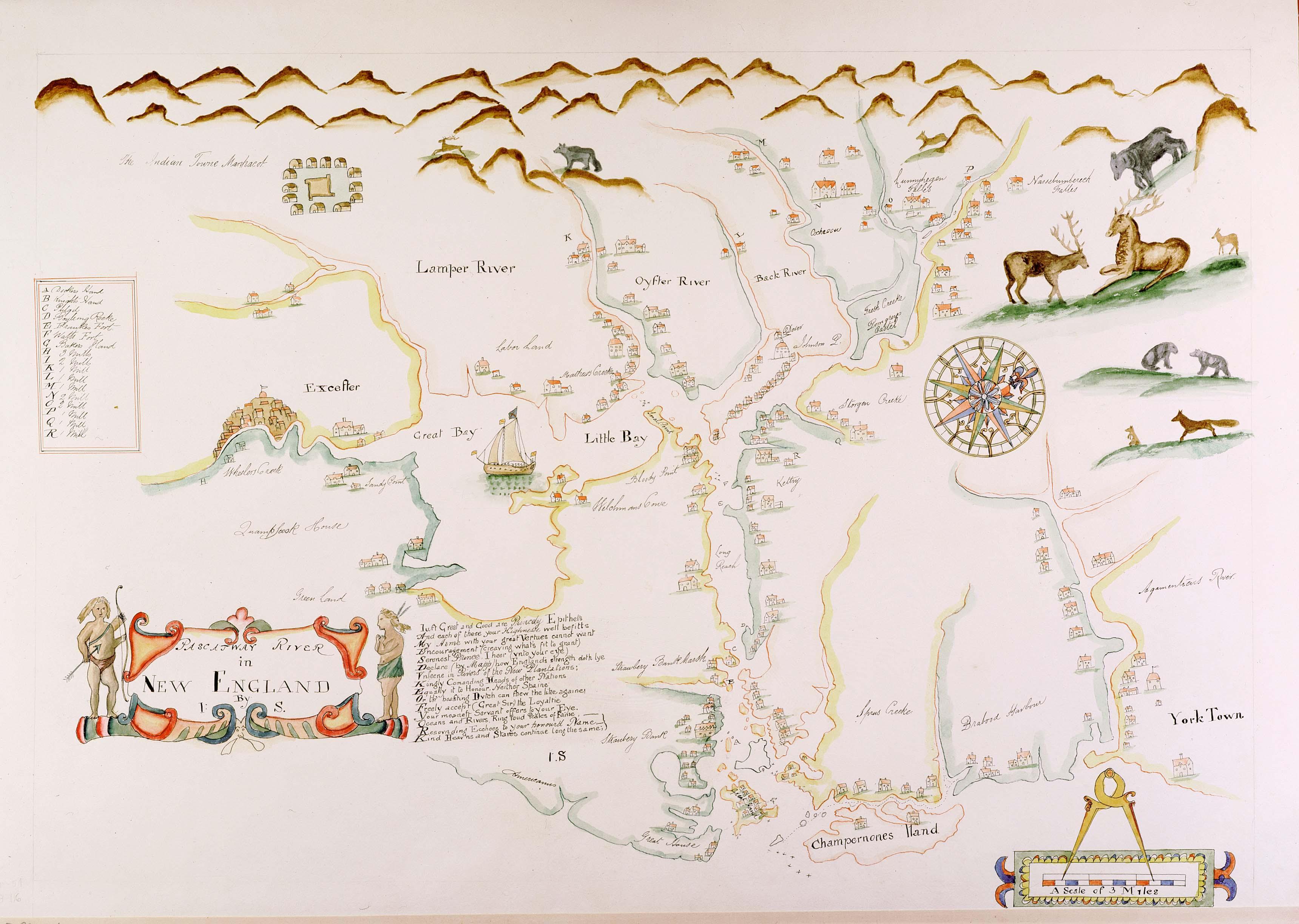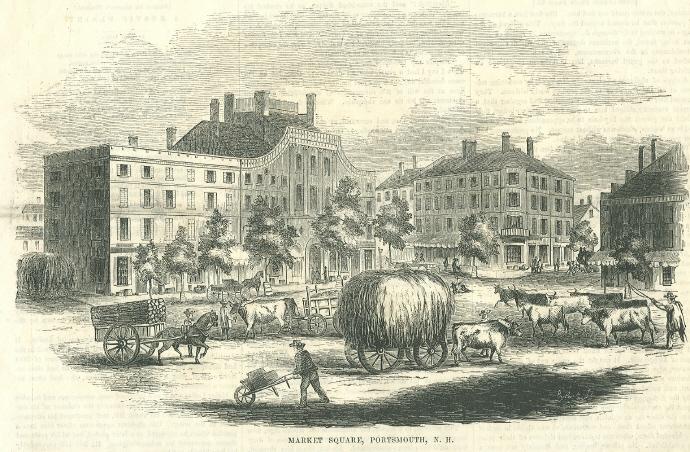|
Gundalow
A gundalow (also known in period accounts as a "gondola") is a type of flat-bottomed sailing barge once common in Maine and New Hampshire rivers. It first appeared in the mid-1600s, reached maturity of design in the 1700 and 1800s, and lingered into the early 1900s before nearly vanishing as a commercial watercraft. Characteristics A form of sailing barge similar to a scow, gundalows characteristically employed tidal currents for propulsion, but shipped a single lateen sail brailed to a heavy yard to harness winds. The yard was attached to a stump mast and heavily counterweighted, pivoting down while still under sail to shoot under bridges while maintaining the boat's way. Up to long, gundalows were fitted with a pivoting leeboard in lieu of a fixed keel, giving them an exceptionally shallow draft and allowing them to "take the hard" (settle into sand, ledge, or mudflats) both for loading and unloading cargoes and maintenance. Cargoes Common cargoes were bricks, timber, cattl ... [...More Info...] [...Related Items...] OR: [Wikipedia] [Google] [Baidu] |
Battle Of Valcour Island
The Battle of Valcour Island, also known as the Battle of Valcour Bay, was a naval engagement that took place on October 11, 1776, on Lake Champlain. The main action took place in Valcour Bay, a narrow strait between the New York mainland and Valcour Island. The battle is generally regarded as one of the first naval battles of the American Revolutionary War, and one of the first fought by the United States Navy. Most of the ships in the American fleet under the command of Benedict Arnold were captured or destroyed by a British force under the overall direction of General Guy Carleton. However, the American defense of Lake Champlain stalled British plans to reach the upper Hudson River valley. The Continental Army had retreated from Quebec to Fort Ticonderoga and Fort Crown Point in June 1776 after British forces were massively reinforced. They spent the summer of 1776 fortifying those forts and building additional ships to augment the small American fleet already on the l ... [...More Info...] [...Related Items...] OR: [Wikipedia] [Google] [Baidu] |
Noble Train Of Artillery
The noble train of artillery, also known as the Knox Expedition, was an expedition led by Continental Army Colonel Henry Knox to transport heavy weaponry that had been captured at Fort Ticonderoga to the Continental Army camps outside Boston during the winter of 1775–76. Knox went to Ticonderoga in November 1775 and moved 60 tons Ware (2000), p. 18 of cannon and other armaments over the course of three winter months by boat, horse, ox-drawn sledges, and manpower along poor-quality roads, across two semi-frozen rivers, and through the forests and swamps of the lightly inhabited Berkshires to the Boston area, Ware (2000), pp. 19–24 N. Brooks (1900), p. 38 covering approximately . Historian Victor Brooks has called Knox's exploit "one of the most stupendous feats of logistics" of the entire American Revolutionary War. V. Brooks (1999), p. 210 The route which he followed is now known as the Henry Knox Trail, and the states of New York and Massachusetts have erected markers alon ... [...More Info...] [...Related Items...] OR: [Wikipedia] [Google] [Baidu] |
Leeboard
A leeboard is a form of pivoting keel used by a sailboat largely and very often in lieu of a fixed keel. Typically mounted in pairs on each side of a hull, leeboards function much like a centreboard, allowing shallow-draft craft to ply waters fixed keel boats cannot. Only the leeward side leeboard is used at any time, as it submerges when the boat heels under the force of the wind. A disadvantage, where there is an inadequate fixed keel, is that they typically ship (bear) little ballast, which being on the far side delays the onset of unballasted craft's heeling, that is, to put up a good, constant resistance against the wind. The classical, archetypal definition of ballast is a low, central weight to optimise centre of mass, reduce turning moment and therefore resistance to the boat keeling over, however tends to be higher in self-righting vessels. Modern developments allow them to act as a speed-enhancing lifting foil. History Leeboards existed in China from at least the e ... [...More Info...] [...Related Items...] OR: [Wikipedia] [Google] [Baidu] |
Lateen Sail
A lateen (from French ''latine'', meaning "Latin") or latin-rig is a triangular sail set on a long yard mounted at an angle on the mast, and running in a fore-and-aft direction. The settee can be considered to be an associated type of the same overall category of sail. The lateen originated in the Mediterranean as early as the 2nd century CE, during Roman times, and became common there by the 5th century. The wider introduction of lateen rig at this time coincided with a reduction in the use of the Mediterranean square rig of the classical era. Since the performance of these two rigs is broadly similar, it is suggested that the change from one to the other was on cost grounds, since lateen used fewer components and had less cordage to be replaced when it wore out. Arab seafarers adopted the lateen rig at a later datethere is some limited archaeological evidence of lateen rig in the Indian Ocean in the 13th century CE and iconographic evidence from the 16th century. It has bee ... [...More Info...] [...Related Items...] OR: [Wikipedia] [Google] [Baidu] |
Piscataqua (ship)
Piscataqua, believed to be an Abenaki word meaning ''rapid waters'', may refer to: * Piscataqua River, a fast-moving estuarine river dividing coastal New Hampshire and Maine in the United States * Piscataqua River (Presumpscot River), a tributary of the Presumpscot River in Maine See also * Piscataquis County, Maine * Piscataquis River, a tributary of the Penobscot River in Maine * Piscataquog River The Piscataquog River is a river located in southern New Hampshire in the United States. It is a tributary of the Merrimack River, which flows to the Gulf of Maine. The Piscataquog River begins at the outlet of Deering Reservoir, a lake in De ..., a tributary of the Merrimack River in New Hampshire * Piscataway (other) {{geodis ... [...More Info...] [...Related Items...] OR: [Wikipedia] [Google] [Baidu] |
Piscataqua River
The Piscataqua River (Abenaki: ''Pskehtekwis'') is a tidal river forming the boundary of the U.S. states of New Hampshire and Maine from its origin at the confluence of the Salmon Falls River and Cochecho River. The drainage basin of the river is approximately , including the subwatersheds of the Great Works River and the five rivers flowing into Great Bay: the Bellamy, Oyster, Lamprey, Squamscott, and Winnicut. The river runs southeastward, with New Hampshire to the south and west and Maine to the north and east, and empties into the Gulf of Maine east of Portsmouth, New Hampshire. The last before the sea are known as Portsmouth Harbor and have a tidal current of around . The cities/towns of Portsmouth, New Castle, Newington, Kittery and Eliot have developed around the harbor. History Named by the area's original Abenaki inhabitants, the word ''Piscataqua'' is believed to be a combination of ''peske'' (branch) with ''tegwe'' (a river with a strong current, poss ... [...More Info...] [...Related Items...] OR: [Wikipedia] [Google] [Baidu] |
Cocheco River
The Cochecho River (incorrectly Cocheco River) is a tributary of the Piscataqua River, long, in the U.S. state of New Hampshire. It rises in northern Strafford County and runs southeastward, through the town of Farmington and the cities of Rochester and Dover, where it provides hydroelectric power. Below the center of Dover, the river is tidal and joins the Salmon Falls River at the Maine border to form the Piscataqua. Significant tributaries include the Ela River, the Mad River, and the Isinglass River. History of the name Cochecho is an Abenaki word meaning "rapid foaming water," referring to Cochecho Falls in downtown Dover. Settlers adopted the name for both the river and their principal settlement, Cochecho village. In 1642, Richard Waldron was granted water privileges at Cochecho Falls, moving there from Dover Point to build a sawmill and gristmill. During the Industrial Revolution, these industries would be supplanted by cotton textile mills. In 1827, the Cocheco M ... [...More Info...] [...Related Items...] OR: [Wikipedia] [Google] [Baidu] |
Dover, New Hampshire
Dover is a city in Strafford County, New Hampshire, United States. The population was 32,741 at the 2020 census, making it the largest city in the New Hampshire Seacoast region and the fifth largest municipality in the state. It is the county seat of Strafford County, and home to Wentworth-Douglass Hospital, the Woodman Institute Museum, and the Children's Museum of New Hampshire. Etymology First recorded in its Latinised form of '' Portus Dubris'', the word "Dover" derives from the Brythonic word for "waters" (''dwfr'' in Middle Welsh). The same element is present in the word's French (''Douvres'') and Modern Welsh (''Dofr'') forms. History Settlement The first known European to explore the region was Martin Pring from Bristol, England, in 1603. In 1623, William and Edward Hilton settled at Pomeroy Cove on Dover Point, making Dover the oldest permanent settlement in New Hampshire, and seventh in the United States. One of the colony's four original townships, it then inclu ... [...More Info...] [...Related Items...] OR: [Wikipedia] [Google] [Baidu] |
Captain Edward Adams
Captain is a title, an appellative for the commanding officer of a military unit; the supreme leader of a navy ship, merchant ship, aeroplane, spacecraft, or other vessel; or the commander of a port, fire or police department, election precinct, etc. In militaries, the captain is typically at the level of an officer commanding a company or battalion of infantry, a ship, or a battery of artillery, or another distinct unit. The term also may be used as an informal or honorary title for persons in similar commanding roles. Etymology The term "captain" derives from (, , or 'the topmost'), which was used as title for a senior Byzantine military rank and office. The word was Latinized as capetanus/catepan, and its meaning seems to have merged with that of the late Latin "capitaneus" (which derives from the classical Latin word "caput", meaning head). This hybridized term gave rise to the English language term captain and its equivalents in other languages (, , , , , , , , , kapitány, K ... [...More Info...] [...Related Items...] OR: [Wikipedia] [Google] [Baidu] |
Portsmouth, New Hampshire
Portsmouth is a city in Rockingham County, New Hampshire, United States. At the 2020 census it had a population of 21,956. A historic seaport and popular summer tourist destination on the Piscataqua River bordering the state of Maine, Portsmouth was formerly the home of the Strategic Air Command's Pease Air Force Base, since converted to Portsmouth International Airport at Pease. History American Indians of the Abenaki and other Algonquian languages-speaking nations, and their predecessors, inhabited the territory of coastal New Hampshire for thousands of years before European contact. The first known European to explore and write about the area was Martin Pring in 1603. The Piscataqua River is a tidal estuary with a swift current, but forms a good natural harbor. The west bank of the harbor was settled by European colonists in 1630 and named Strawbery Banke, after the many wild strawberries growing there. The village was protected by Fort William and Mary on what is now ... [...More Info...] [...Related Items...] OR: [Wikipedia] [Google] [Baidu] |
Coast Guard
A coast guard or coastguard is a maritime security organization of a particular country. The term embraces wide range of responsibilities in different countries, from being a heavily armed military force with customs and security duties to being a volunteer organization tasked with search and rescue without law enforcement authority. In most countries, a typical coast guard's functions are distinct from those of the navy (a military service) and the transit police (a law enforcement agency), while in certain countries has similarities to both. History The predecessor of the United Kingdom's modern His Majesty's Coastguard was established in 1809 as the Waterguard, a department of the HM Customs and Excise authority, which was originally devoted to the prevention of smuggling. At the time, due to high UK taxation on liquors such as brandy, and on tobacco etc., smuggling of such cargoes from places such as France, Belgium, and Holland was an attractive proposition for ma ... [...More Info...] [...Related Items...] OR: [Wikipedia] [Google] [Baidu] |






.jpg)